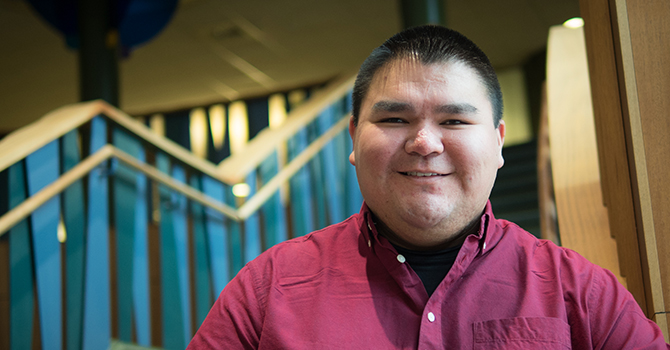Conducting Culturally Competent Public Health Work in Native Communities

Joel Begay
MPH Candidate, Hospital and Molecular Epidemiology
As an undergraduate, I didn't know what public health was. I was on the medical school route. After I graduated from Colorado College in 2014 I worked for two years as a medical and surgical assistant in a dermatology clinic specializing in the diagnosis and treatment of skin cancer. As an MA, I received plenty of patient care experience, which I liked, and I learned how common skin cancer was - especially in Colorado, where there's plenty of sunshine and people enjoy being outdoors. I thought, 'how common is skin cancer in Colorado compared to other states?' Unknowingly, I was learning about incidence and prevalence and other foundations of epidemiology. After noticing the numerous cases of skin cancer, I wanted to better understand cancer epidemiology and how we can prevent skin cancer, as well as other cancers.
I stumbled upon public health while working in a dermatology clinic. I started to learn about the distribution and determinants of disease, also known as epidemiology. However, I was still interested in medicine, so I looked at graduate programs that blended my interests in medicine and public health. The Hospital & Molecular Epidemiology (HME) program at Michigan Public Health was the only program that did just that, making it a good fit. Many other public health programs offered general epidemiology or other broad fields of epidemiology, like chronic disease. However, I knew that the HME training would be something I could employ as an aspiring clinician. I could learn about a variety of organisms, their modes of transmission, and infection prevention and control.
Currently, I'm working with physicians in neurology and radiology at Michigan Medicine at the University of Michigan. As a research assistant, I collect patient data, perform data analyses, and I am currently writing manuscripts for the respective projects. In terms of my neurology research project, I am attempting to identify trends within the data surrounding a clinical trial treatment for secondary progressive Multiple Sclerosis. My work with Dr. Yang Mao-Draayer has led to a growing interest in chronic disease, which in turn, led me to the Cancer Epidemiology Education in Special Populations (CEESP) Fellowship. Through CEESP, I encountered my radiology research project, investigating breast cancer screening adherence among American Indian women. These projects employ similar epidemiologic methods and data analyses to explore disease, but do so differently. My public health research will allow me to approach medicine from a different perspective.
I have come to learn the importance of acknowledging the history of native communities and research, as well as the politics surrounding these projects. Thus, I aspire to conduct culturally competent public health research.
My experience as a Fellow with the Cancer Epidemiology Education in Special Populations (CEESP) Program has been interdisciplinary, incorporating many pillars of public health. Originally established at the University of Michigan School of Public Health, CEESP has expanded to incorporate other academic institutions including the University of Nebraska Medical Center. Through CEESP, I met Dr. Marilyn Roubidoux in the Department of Radiology at Michigan Medicine. As a native physician, Dr. Roubidoux has provided invaluable mentorship for both my research project and for my professional development. By working with Dr. Roubidoux, I have come to learn the importance of acknowledging the history of native communities and research, as well as the politics surrounding these projects. Thus, I aspire to conduct culturally competent public health research.
My work with Native communities has provided insight on how to partner with communities in a way that does not exploit them. American Indians are a minority among the minority - and often times there isn't enough data available for research. In general, there is minimal data resulting in disparities in both quantitative and qualitative data - even among the data that is available, there's a lack of quality. As a public health professional, I want to help fill that gap by collecting and analyzing data while helping tribal governments, health professionals, and other government agencies interpret the data to ultimately improve Indian Country.
I joined the University of Michigan 'Diversity, Equity, and Inclusion' (DE&I) initiatives because I wanted to represent and amplify the native student voice on campus. I serve on the DEI Student Advisory Board (DEISAB) with 49 other graduate and professional students from across campus. We convene once a month with the UM Office of the Vice President for Student Life to discuss issues and potential solutions before they're unveiled to the University at-large. The DEISAB seeks to represent the interests of graduate and professional students. We are a small community with very different backgrounds. Many of us are not traditional students – Many members have families and their kids attend the monthly meetings. We've become a family.
Conversations about DE&I are ongoing and the longer we wait to join them, the longer we don't have a voice. When I learned about the Department of Epidemiology's DE&I Student Representative position at Michigan Public Health, I stepped in. We're building community at the department and school-level, in an effort to create a welcoming and warm space. We're not going to achieve it overnight, it's going to take some time, but that's public health, right?
